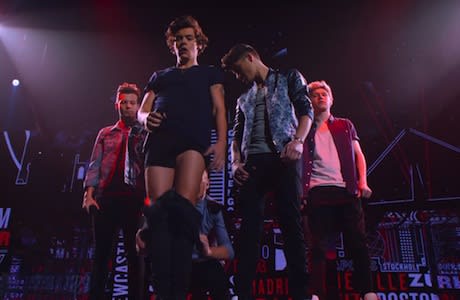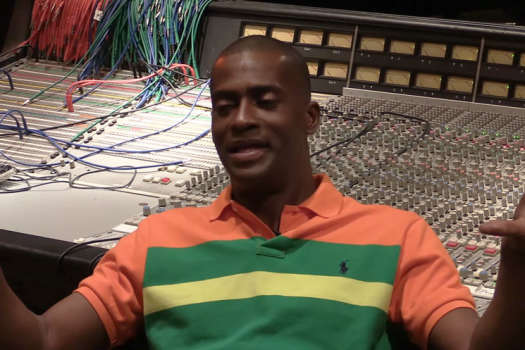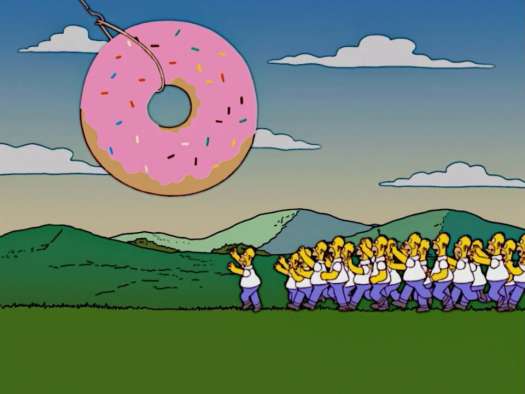In 2004, Morgan Spurlock's Oscar-nominated Super Size Me found the director eating nothing but McDonald's for 30 days, subsequently suffering from a slew of ailments, including weight gain, sexual dysfunction, mood swings and liver disease. His film tackled the epidemic of obesity in America, which continues to balloon at epic proportions, giving those looking to feel arbitrarily superior to others a politically correct way to discriminate.
Rather than focus his attention on another serious societal issue, Spurlock's latest project finds the documentarian making a film about current boy band sensation One Direction. Given his propensity for utilizing idiosyncratic ways to deal with presenting dry, media-saturated issues (i.e., product placement and finding Osama bin Laden), we could have hoped the film would find him listening to their music for 30 days or immersing himself in the fanatical (read: maniacal) tween pop world, fighting 14-year-old girls to get front and center for the sanitized, repetitive "music" of the manufactured "band." Sadly, needing to fulfill the obligations of a paycheque gig, he documents a straightforward account of the group's rise to fame, mixed with current concert tour highlights, in One Direction: This is Us.
The film begins in generic documentary format, chronicling the beginning of the English/Irish five-piece. The boys auditioned individually for The X Factor, but were eventually grouped together, thanks to Simon Cowell's predilection for appeasing mass superficiality. The boys immediately became the darlings of the British television reality program, making it all the way to the end. They finished in third place, but Cowell snatched them up and signed them to his record label.
Spurlock uses voiceover interviews with each member recounting their fabled rise to stardom, juxtaposing archival footage against the reality series. Up to this point, This is Us, though formulaic, appears to have more than an ounce of substance. Unfortunately, the film's authenticity is immediately derailed when Cowell makes his appearance ten minutes in to argue that One Direction's rise to fame was entirely organic. Worse, he does so with a straight face, almost as if he believes what he's saying, not getting the Josie and the Pussycats subtext of it all.
While the pre- and post-concert behind-the-scenes footage gives viewers a glimpse of the boys in their "natural" state, the emphasis is quite obviously on the concert footage. It's within the live performances that the gaudy 3D rears its head, confronting us with streamers and miscellaneous objects flying out of the screen. A video set similarly zooms around the stage, creating a visual distraction, when the lads aren't jumping up and down, causing digital ripples that reverberate into the audience. The use of 3D is intended to add a hint of hyper-reality, but only serves to interfere with the glorified karaoke on display.
However, although the actual assemblage of concert footage is abrasive and uninspired, the group have sold more than 13 million records worldwide to a demographic less concerned with integrity and demonstrating consciousness for what they're consuming than seeing their favourite, dreamiest androgynous (non-threatening and sexually ambiguous) boy. As such, the gaudiness will likely go unnoticed by the younger female demographic.
By the end of the film's 92-minute runtime, we're left with very little insight into the group themselves. We understand Cowell's motivations and the inherent marketability of asexual ciphers to a generation of culturally passive, reactionary thinkers, but this bit of cash-in fluff does little to expand upon what fans are already overly familiar with.
(Sony)Rather than focus his attention on another serious societal issue, Spurlock's latest project finds the documentarian making a film about current boy band sensation One Direction. Given his propensity for utilizing idiosyncratic ways to deal with presenting dry, media-saturated issues (i.e., product placement and finding Osama bin Laden), we could have hoped the film would find him listening to their music for 30 days or immersing himself in the fanatical (read: maniacal) tween pop world, fighting 14-year-old girls to get front and center for the sanitized, repetitive "music" of the manufactured "band." Sadly, needing to fulfill the obligations of a paycheque gig, he documents a straightforward account of the group's rise to fame, mixed with current concert tour highlights, in One Direction: This is Us.
The film begins in generic documentary format, chronicling the beginning of the English/Irish five-piece. The boys auditioned individually for The X Factor, but were eventually grouped together, thanks to Simon Cowell's predilection for appeasing mass superficiality. The boys immediately became the darlings of the British television reality program, making it all the way to the end. They finished in third place, but Cowell snatched them up and signed them to his record label.
Spurlock uses voiceover interviews with each member recounting their fabled rise to stardom, juxtaposing archival footage against the reality series. Up to this point, This is Us, though formulaic, appears to have more than an ounce of substance. Unfortunately, the film's authenticity is immediately derailed when Cowell makes his appearance ten minutes in to argue that One Direction's rise to fame was entirely organic. Worse, he does so with a straight face, almost as if he believes what he's saying, not getting the Josie and the Pussycats subtext of it all.
While the pre- and post-concert behind-the-scenes footage gives viewers a glimpse of the boys in their "natural" state, the emphasis is quite obviously on the concert footage. It's within the live performances that the gaudy 3D rears its head, confronting us with streamers and miscellaneous objects flying out of the screen. A video set similarly zooms around the stage, creating a visual distraction, when the lads aren't jumping up and down, causing digital ripples that reverberate into the audience. The use of 3D is intended to add a hint of hyper-reality, but only serves to interfere with the glorified karaoke on display.
However, although the actual assemblage of concert footage is abrasive and uninspired, the group have sold more than 13 million records worldwide to a demographic less concerned with integrity and demonstrating consciousness for what they're consuming than seeing their favourite, dreamiest androgynous (non-threatening and sexually ambiguous) boy. As such, the gaudiness will likely go unnoticed by the younger female demographic.
By the end of the film's 92-minute runtime, we're left with very little insight into the group themselves. We understand Cowell's motivations and the inherent marketability of asexual ciphers to a generation of culturally passive, reactionary thinkers, but this bit of cash-in fluff does little to expand upon what fans are already overly familiar with.




